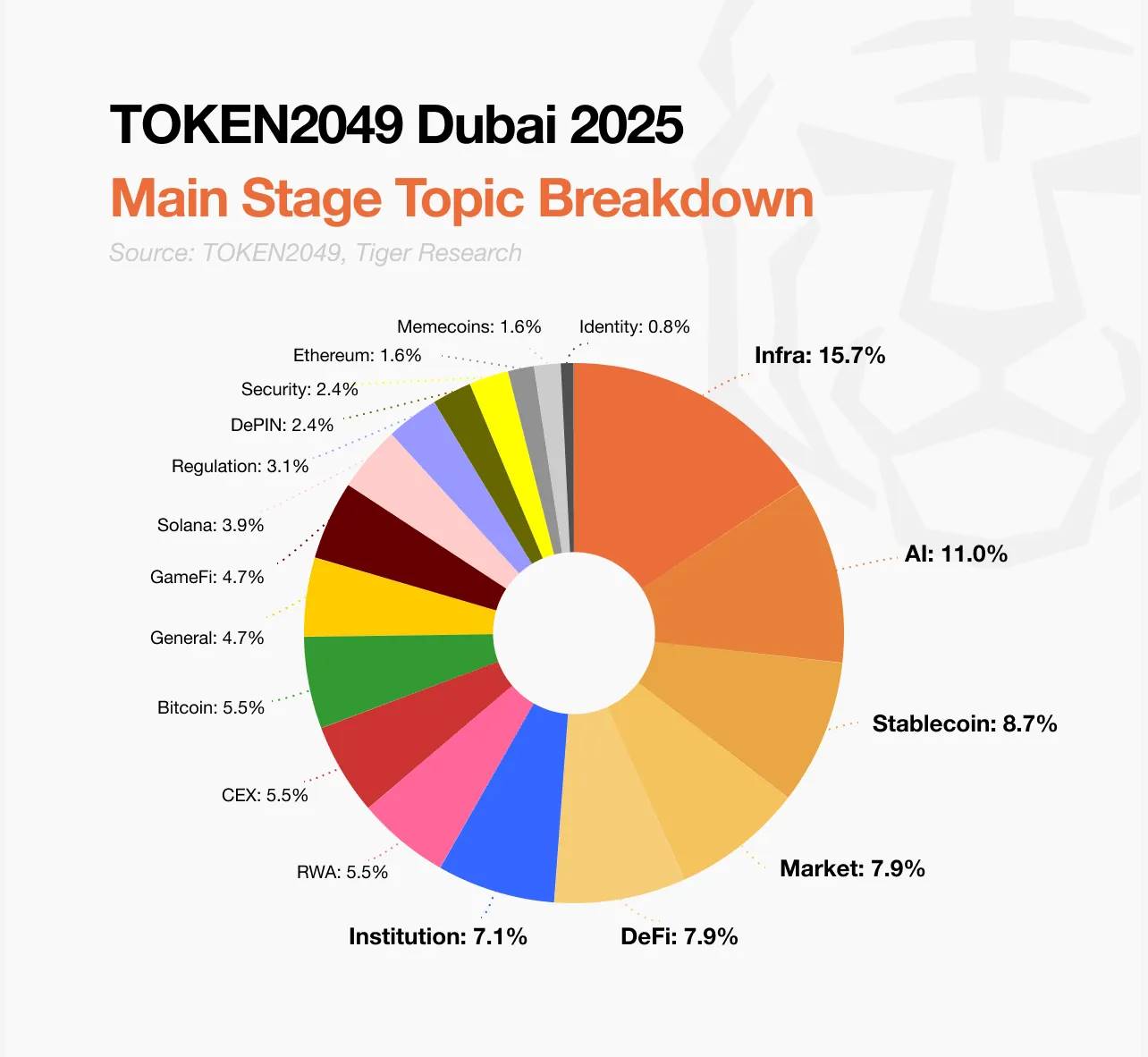This report, written by Tiger Research , provides an in-depth analysis of the key trends from the TOKEN 2049 Dubai Conference, revealing that stablecoins are emerging as critical infrastructure, while the crypto industry is gradually moving from speculation to practical applications.
Summary of key points
Stablecoins become core infrastructure. Stablecoins, once narrative-driven, have now demonstrated clear product-market fit and are establishing themselves as a core component of the digital economy.
AI expectations outstrip actual progress. Although AI was a major theme at the conference (accounting for 11% of the agenda), many attendees pointed out that the gap between industry hype and actual progress is widening.
The industry has entered a stage of structural maturity. The crypto industry is transitioning from the speculative frontier era to a stage centered on infrastructure construction and real use cases. The markets demand for proven applications and clear value propositions gradually exceeds expectations for conceptual innovation.
1.TOKEN 2049: A strategic indicator of the Web3 market direction
Source: Token 2049
According to the research report , TOKEN 2049 Dubai 2025 once again consolidated its position as the worlds top crypto industry event, attracting more than 15,000 participants from more than 160 countries. The two-day conference covered a series of high-profile speeches and discussions, reflecting the evolution of market dynamics and the rise of emerging trends.
As an important forum in the industry, TOKEN 2049 is regarded as a barometer of the future direction and narrative shift of the Web3 market. This report systematically reviews the main contents of TOKEN 2049 Dubai 2025, categorizes and deeply analyzes some important announcements according to core themes, and captures the changes in the overall priorities of the ecosystem, providing strategic insights to help interpret the future potential direction of the industry.
2. Emerging trends: What does the agenda reveal?

Source: TOKEN 2049, Tiger Research
TOKEN 2049 Dubai 2025 covers a wide range of blockchain topics, fully demonstrating the evolution of industry priorities. Infrastructure-related topics account for the largest proportion (15.7%), followed by AI (11%). Although the initial enthusiasm around AI agents has cooled, the continued integration efforts of AI and blockchain show that this topic is still structurally important.
It is worth noting that the combined proportion of stablecoins (8.7%) and real assets (RWA, 5.5%) has surpassed AI. This reflects the markets growing interest in blockchain applications with direct practicality. In particular, stablecoins have attracted much attention due to their actual value in payment and settlement, while RWA has become a leading category for the next generation of blockchain applications.

dYdX founder Antonio discusses hot issues: Is DeFi eating up CeFi? Slowly and suddenly. Source: dYdX
In this years DeFi discussion, the industrys perspective is more mature than in previous years. Instead of focusing on replacing traditional finance, the focus of the discussion has shifted to how decentralized systems can complement existing institutions. This is also consistent with the industrys overall trend towards regulatory involvement and institutional adoption.
One notable change is the growing attention paid to the Solana ecosystem. Despite suffering a major blow during the FTX debacle, the Solana ecosystem has successfully rebounded and is now even more prominent on the scene and in more technical discussions than Ethereum. This shift in ecosystem dynamics is worth paying close attention to and has the potential to be an inflection point in the Layer 1 blockchain landscape.
Overall, the main stage of the conference showed a more down-to-earth and pragmatic way of thinking. Although eye-catching elements such as meme coins and celebrity appearances still exist, they are only secondary. The core discussions revolve around long-term growth drivers, including regulation, financial integration, infrastructure construction and artificial intelligence.
3. Deep changes beyond the spotlight
As in previous years, the most meaningful developments often occurred off the stage. Side events and closed-door meetings revealed deeper industry dynamics, strategic reshaping, and fundamental shifts in direction—factors that often had a profound impact on the market long before the public narrative.
3.1 Stablecoins have become infrastructure
Stablecoins have now been established as the core infrastructure of the digital economy and are seen as a key opportunity in the Web3 space. There is a growing view that stablecoin transactions will expand from on-chain activities to the real economy, potentially forming a trillion-dollar market. This prospect has attracted more and more participants to enter the stablecoin space.
As this view solidifies, the industrys focus has shifted from simple integration to control of the payment layer. The goal is not just to stop at the issuance stage, but to extend to building end-to-end financial infrastructure. Web3 projects and institutions are stepping up their efforts to take a leading position in the stablecoin technology stack.
Although still in its early stages, this shift has already driven ecosystems such as Solana, Tron, and TON to accelerate their efforts to establish themselves as foundational settlement platforms. Their strategies are not limited to the issuance of stablecoins, but also cover wallet development, payment infrastructure construction, and institutional adoption.
3.2 AI in Crypto: Exciting but Still Experimental
A general tone of caution prevailed in the discussion about AI. Many participants pointed out that the gap between market enthusiasm and the maturity of current technological developments is widening. In particular, some AI agent projects have been criticized for lacking clear use cases, further deepening the perception that much of the activity in the field is still speculative.
Despite these concerns, there is long-term confidence in the potential role of Web3 in the AI market. Concepts such as decentralized AI computing and open-source agent frameworks are seen as areas with real potential. These are seen as long-term opportunities rather than short-term trends and are expected to gradually gain traction after the current market noise subsides.
While AI continues to attract widespread attention, most attendees agreed that the field should be approached from a long-term perspective, with the current focus still on basic experiments rather than immediate large-scale applications.
3.3 Node Sales Boom
A notable trend at the conference was the growing focus on node sales associated with physical equipment. By opening node operation to a wider audience — something that was once limited to a select few — these initiatives are seen as an important step toward greater decentralization and redistributing participation opportunities.
However, some attendees were skeptical of the trend. They questioned whether these sales were just retail funding strategies wrapped in ecosystem participation. Criticisms focused on inflated reward structures, unclear token models, and a lack of meaningful network activity to support the sales.
Despite these skepticism, multiple projects have attracted significant capital and attention. However, their long-term viability remains uncertain and will ultimately depend on the performance of the network’s actual utility.
3.4 Technology is no longer the only bargaining chip
The gap between technological progress and market adoption continues to widen. Even teams with strong technical capabilities admit that continued research alone is no longer enough to attract market interest. Many technically mature protocols have failed to gain user attention, while some simple meme coins launched through meme platforms continue to generate stable trading volume.
In response, industry participants are shifting their focus from research to execution. More and more efforts are focused on developing strategic market entry plans, understanding liquidity flows, building exchange relationships, and designing user-friendly token models. While technical excellence remains important, the ability to create meaningful value will be limited without an effective distribution strategy.
Market participants are increasingly concerned that short-term returns and immediate utility are taking precedence over long-term innovation. In the current environment, execution trumps potential. The market has evolved into a competitive arena where technology alone cannot ensure survival.
4. Key Announcements
Tether – Launching a new compliant USD stablecoin program
Tether CEO Paolo Ardoino announced plans to launch a new U.S. dollar stablecoin that meets U.S. compliance requirements, different from the existing USDT, which is expected to be released in 2025-2026. The plan reflects Tethers continued efforts in regulatory engagement and includes discussions with U.S. lawmakers.
OKX – Launch of OKX Pay and Institutional Partnership Program
OKX launched OKX Pay, a crypto payment app that supports user self-custody, offers zero-fee transfers, and enables wallet recovery through shared key technology. In addition, OKX also disclosed a number of institutional collaborations, including cooperation with Standard Chartered Bank in Dubai’s VARA regulatory sandbox, and announced integration plans with Mastercard and Stripe.
Zodia Custody – Entering the UAE market and strengthening regulatory cooperation
Zodia announced the acquisition of Tungsten Custody to establish a regulated base of operations in the UAE. Zodia also unveiled a new custody partnership with Bybit and released a joint custody framework with the Abu Dhabi regulator.
Mesh – Retail Crypto Payment Integration
Mesh demonstrated its new integration with Apple Pay, allowing users to pay with cryptocurrencies and merchants to receive stablecoins. The feature is based on Mesh’s “SmartFunding” solution, scheduled to launch in the second quarter of 2025, and is designed to simplify the crypto payment process in retail environments.
World Liberty Financial and TRON – $2 billion stablecoin investment
Abu Dhabi’s MGX Fund has completed a $2 billion investment in Binance through the stablecoin USD 1. Once the transaction is completed, USD 1 will be natively integrated into the TRON ecosystem.
MEXC Ventures – Launch of Ecosystem Development Fund
MEXC Ventures announced a $300 million fund focused on investing in modular chains, ZK-rollups, and self-custody solutions. The move reflects renewed interest in infrastructure investments after the 2022 market downturn.
Lightspark – Bitcoin-based payment infrastructure
Former PayPal executive David Marcus launched Spark, a native protocol based on Bitcoin’s Lightning Network. The protocol aims to enable high-speed, low-cost payments and expand Bitcoin’s use cases beyond “value storage.”
These announcements fit in well with the themes of TOKEN 2049. Stablecoins remain a core topic, as evidenced by Tether’s compliance program and $2 billion investment case based on stablecoins. Infrastructure development is also another major focus, with companies such as OKX, Zodia, and MEXC making particularly notable efforts in scalability, custody, and modular architecture.
The evolution of Bitcoin’s functionality was also highlighted through Lightspark’s Spark Protocol, furthering the discussion about Bitcoin’s potential for broader adoption. While AI featured prominently in the presentations, it was relatively invisible in the main announcements. Instead, the focus remained on real-world deployments in payments, compliance, and institutionalized access, marking the industry’s continued transition from the experimental phase to scaled implementation.
5. From frontier to urbanization
This year’s conference clearly demonstrated the crypto industry’s shift from speculative enthusiasm to a focus on practicality and infrastructure development. Three key themes emerged:
Stablecoins go beyond narratives and become the infrastructure of the digital economy
Stablecoins are no longer just a concept, but have demonstrated real product-market fit, gradually establishing their position as the core infrastructure of the digital economy.
AI is gaining popularity, but market sentiment is becoming cautious
Despite the attention paid to AI at the conference, many attendees noted that the gap between market enthusiasm and the actual maturity of AI technology development is widening.
Dubai solidifies its position as Web3 regulatory and capital hub
The UAE continues to play a leading role in the global expansion of Web3, with Dubai becoming an important regulatory and capital hub for this space.
Rather than introducing a whole new wave of trends, the conference highlighted the further consolidation of existing narratives, especially around themes such as AI, stablecoins, and real-world assets (RWA). The increase in institutional participation and the continuous improvement of regulatory frameworks indicate that the market is entering a new stage of structural transformation.
The era of idealistic experimentation is giving way to a phase of pragmatic execution. Just as the transition from a frontier economy to an urbanized economy was driven by revolutions in transportation and distribution, the Web3 ecosystem is now entering a phase that relies on infrastructure construction, system integration, and delivery capabilities.
While the attention economy remains an important factor, the market is no longer just paying for conceptual innovation. Stakeholders now expect practical applications and clear value propositions. This shift signals a broader maturity of the entire ecosystem, paving the way for more stable, long-term development - it can be considered the arrival of the urbanization era of Web3.










